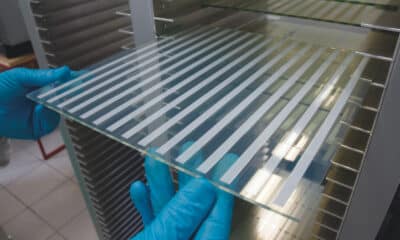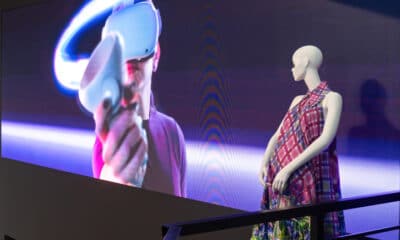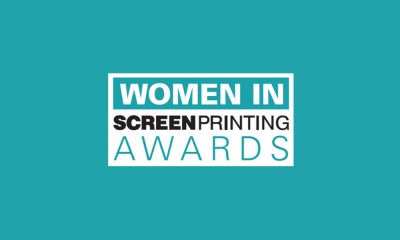Articles
The Challenges of Functional Inkjet Printing
Published
8 years agoon

Printing done within industrial manufacturing processes has traditionally been dominated by analog methods, particularly screen printing. Inkjet is increasingly becoming part of the discussion, however. Beyond well-known commercial applications, such as signage and outdoor advertising, inkjet printing now commands the majority of the market for tile decoration. Almost all expiration dates and batch codes on beverage cans are inkjet printed. Inkjet is playing an increasing role in printing glass, packaging, flooring, laminates, and other home décor products.
Printing done within industrial manufacturing processes has traditionally been dominated by analog methods, particularly screen printing. Inkjet is increasingly becoming part of the discussion, however. Beyond well-known commercial applications, such as signage and outdoor advertising, inkjet printing now commands the majority of the market for tile decoration. Almost all expiration dates and batch codes on beverage cans are inkjet printed. Inkjet is playing an increasing role in printing glass, packaging, flooring, laminates, and other home décor products.
While these applications take place as part of a manufacturing process, and are therefore industrial, they are (arguably) decorative in nature. Some of the more exciting industrial work being done today involves printing that imparts functional characteristics to the final product. Applications such as conductive and insulated patterns and circuits, electronics, LCD and OLED display screens, photovoltaic fabrication, optics, and a host of medical work,including the printing of biological materials, only hint at the possibilities.
These fields are growing rapidly, but to this point, are not converting from analog to digital technology as rapidly as some sectors of the commercial printing industry. I’ll look at some of the challenges of functional printing and the developers working to address them below. I’ll be looking at inkjet and inkjet-like non-contact methods of depositing inks and other materials – not just continuous inkjet (CIJ), piezo inkjet (PIJ), and thermal inkjet (TIJ), but also similar processes that have been adapted for industrial use. (1) These related technologies can sometimes extend the capabilities of existing inkjet systems – for example, by providing the ability to jet larger particles and higher viscosity fluids. I won’t spend much time on decorative applications or 3D additive-manufacturing inkjet technology. (See “A Very Brief History of Industrial Inkjet Printing” for more on these fields.)
Inkjet’s Advantages
Many of the forces that have driven inkjet’s development in commercial applications for the past few decades – custom printing capabilities, reduced production time and expense, and so on – also apply to industrial work. Today, we’re beginning to see the profound impact that inkjet could have on the manufacturing and supply of products. It has already enabled mass customization, just-in-time delivery, and reduced inventory risk, as well as improving manufacturing processes.
Since inkjet printheads do not touch or apply pressure to the print surface, they can print many substrates, such as silicon printed circuit boards, that screen printing and other on-contact analog methods might distort or break. Inkjet can also print surfaces that are not perfectly flat.
Single-pass inkjet systems have begun to arrive and are printing at speeds that rival those of analog printing for longer print runs. Single-pass inkjet textile printing systems, such as the MS LaRio from MS Printing Solutions (Caronno Pertusella, Italy) and the new Pike system from SPGPrints (Boxmeer, The Netherlands), offer throughput speeds that compete with those of rotary screen, but without the time and expense of screen making, setup, cleaning, and storage. Single-pass inkjet label and ceramic tile printers are also attracting the attention of product manufacturers, and bottles and beverage cans are now inkjet printed at speeds approaching analog.
Inkjet printing also enables distribute-and-print strategies, whereby files produced in one place can be sent to print locations around the globe for execution. Since inkjet uses easily transferred binary data to compose and print images, printing can be done anywhere with an internet connection within minutes. Product transportation costs and delays can be avoided. Messages can be adjusted for specific languages and cultures, while common elements such as brand identity are maintained.
Some developers have created systems that combine the advantages of analog and digital technologies. Inkjet print modules can add variable data and inline images to analog presses.
Product and Process Development
Innovative printhead technology has driven much of inkjet’s move into the industrial field. Recognizing that industrial development typically begins in a laboratory testing environment, Fujifilm Dimatix (Santa Clara, California) developed a PIJ-based printer for this market using its micro-electrical-mechanical systems (MEMS) technology. The Dimatix Materials Printer DMP-2831 has become a standard tool for academic and corporate users experimenting with fluid deposition. It uses relatively inexpensive, disposable 16-nozzle PIJ cartridges with a 1.5-milliliter reservoir capacity. Dimatix offers two cartridge types (with 1- or 10-picoliter droplet sizes). Labs and research and development operations also use the DMP-2831 to evaluate the jetting capability of different chemistries, as well as interactions with substrates and performance in the intended application. Some of the medical research being done with this technology – depositing and patterning collagens, cells, proteins, DNA arrays and other biological materials, for example – is mind-boggling stuff.
In its former identity as Spectra, Dimatix also developed its Merlin conveyor-belt production printer for manufacturing environments. One of its first applications was for Procter & Gamble to print images with certified food coloring onto Pringles potato chips. Richard Baker, who led the development, now heads Integrity Industrial Inkjet Integration (West Lebanon, New Hampshire), another company that integrates inkjet systems for a wide range of industrial applications.
AdvertisementOther leading industrial inkjet integrators include Inx Digital’s Evolve group (Owens Cross Roads, Alabama); Prototype & Production Systems (Minneapolis); Cyan Tec Systems (Loughborough, UK); HSAUSA (Perth Amboy, New Jersey); ImTech (Corvallis, Oregon); Amica Systems (Irvine, California); Industrial Inkjet (Swavesey, Cambridgeshire, UK); Xennia, a Sensient Company, (Letchworth, Hertfordshire, UK); Meyer Burger’s Pixdro Group (Eindhoven, The Netherlands); and The Technology Partnership (Melbourn, Hertfordshire, UK). Also, Global Inkjet Systems (Cambridge, UK) provides key integration process elements, including electronics and software, for driving PIJ printheads from Fujifilm Dimatix, Konica Minolta, Kyocera, Ricoh, Toshiba Tec, and Xaar.
A number of companies that develop printheads also build custom inkjet systems for industrial clients. Material science and chemistry developers typically use these custom systems to test and formulate new inks, dispersions, coatings, conductive inks, adhesives, masking fluids, and functional polymers, as well as substrate-wetting and material-adhesion properties. They provide the platforms for research and development of new life science and industrial products including photovoltaic solar cells; RFID tags; LCD, OLED, and PLED displays; sensors; and printed circuits, among other products. Many of these platforms include drop watchers to measure fluid characteristics, drop formation, and transit, and enable tuning of printhead waveforms. These devices can also make product samples, prototypes, and electronic circuits.
Ink and Substrate Chemistry
While printheads, electronics, and software are essential for industrial inkjet project development, the best place to begin a project, arguably, is with the performance characteristics of the materials – that is, the inkjet inks and fluids along with the intended substrates. Experts say that industrial inkjet projects tend to advance more quickly if the discussion begins with the requirements of the ink and fluid characteristics rather than specific printheads or machines. This allows the developers to set their sights on the project goals, while excluding printheads, electronics, and print systems that cannot deposit the required fluids within the desired production parameters. Ink formulators and substrate providers also then have clear specifications for creating their contributions.
Continue reading with Inkjet’s Industrial Limitations.
(1) Traditional digital and some 3D printing include dry and liquid toner electrophotography, electrostatic (E-stat), Continuous (CIJ) and Drop-on-Demand (DOD) inkjet and Valve-jet, Thermal and Thermal Transfer, Laser Induced Forward Transfer (LIFT), Photon-jet, and Tonejet. Other digital 3D print methods include: Stereo-lithography (SLA), Selective Laser Sintering (SLS), Selective Laser Melting (SLM), Electron Beam Melting (EBM), Electron Beam Freeform Fabrication (EBF3), Cold Metal Transfer (CMT), Shaped Deposition Manufacturing (SDM), Laminated Object Manufacturing (LOM), Solid Ground Curing (SGC), Ultrasonic Consolidation (UC) (UAM), Very High Power Ultrasonic Additive Manufacturing (VHP UAM), Integrated Extrusion Deposition (IED/PED), Near Field Electro-Spinning (NFES), Film Transfer Imaging (FTI), Fused Deposition Modeling (FDM)/ Fused Filament Fabrication (FFF), Laser Engineered Net Shaping (LENS), Selective area laser deposition (SALD), 3D Inkjet (3DIJ), Polyjet Modeling (PJM) & Multijet Modeling (MJM), Inkjet Liquid Binding Powder (IJLBP), Flatjet, Aerosol Jet, AIST, Syringe Deposit such as Robo-casting (RC) & Fab@home, Electrostatic Inkjet, and Bio-fabrication (BIO).

SPONSORED VIDEO
Let’s Talk About It
Creating a More Diverse and Inclusive Screen Printing Industry
LET’S TALK About It: Part 3 discusses how four screen printers have employed people with disabilities, why you should consider doing the same, the resources that are available, and more. Watch the live webinar, held August 16, moderated by Adrienne Palmer, editor-in-chief, Screen Printing magazine, with panelists Ali Banholzer, Amber Massey, Ryan Moor, and Jed Seifert. The multi-part series is hosted exclusively by ROQ.US and U.N.I.T.E Together. Let’s Talk About It: Part 1 focused on Black, female screen printers and can be watched here; Part 2 focused on the LGBTQ+ community and can be watched here.
You may like
Advertisement

Inkcups Announces New CEO and Leadership Restructure

Hope Harbor to Receive Donation from BlueCotton’s 2024 Mary Ruth King Award Recipient

Livin’ the High Life
Advertisement
Subscribe

Bulletins
Get the most important news and business ideas from Screen Printing magazine's news bulletin.
Advertisement
Most Popular
-

 Art, Ad, or Alchemy1 month ago
Art, Ad, or Alchemy1 month agoF&I Printing Is Everywhere!
-

 Case Studies1 month ago
Case Studies1 month agoHigh-Density Inks Help Specialty Printing Take Center Stage
-

 Andy MacDougall1 month ago
Andy MacDougall1 month agoFunctional and Industrial Printing is EVERYWHERE!
-

 Columns2 weeks ago
Columns2 weeks ago8 Marketing Mistakes Not to Make When Promoting Your Screen Printing Services Online
-

 Editor's Note2 weeks ago
Editor's Note2 weeks agoLivin’ the High Life
-

 Thomas Trimingham2 months ago
Thomas Trimingham2 months ago“Magic” Marketing for Screen Printing Shops
-

 Marshall Atkinson2 weeks ago
Marshall Atkinson2 weeks agoHow to Create a Winning Culture in Your Screen-Printing Business
-

 News & Trends1 month ago
News & Trends1 month agoWhat Are ZALPHAS and How Can You Serve Them in Your Print Business?












